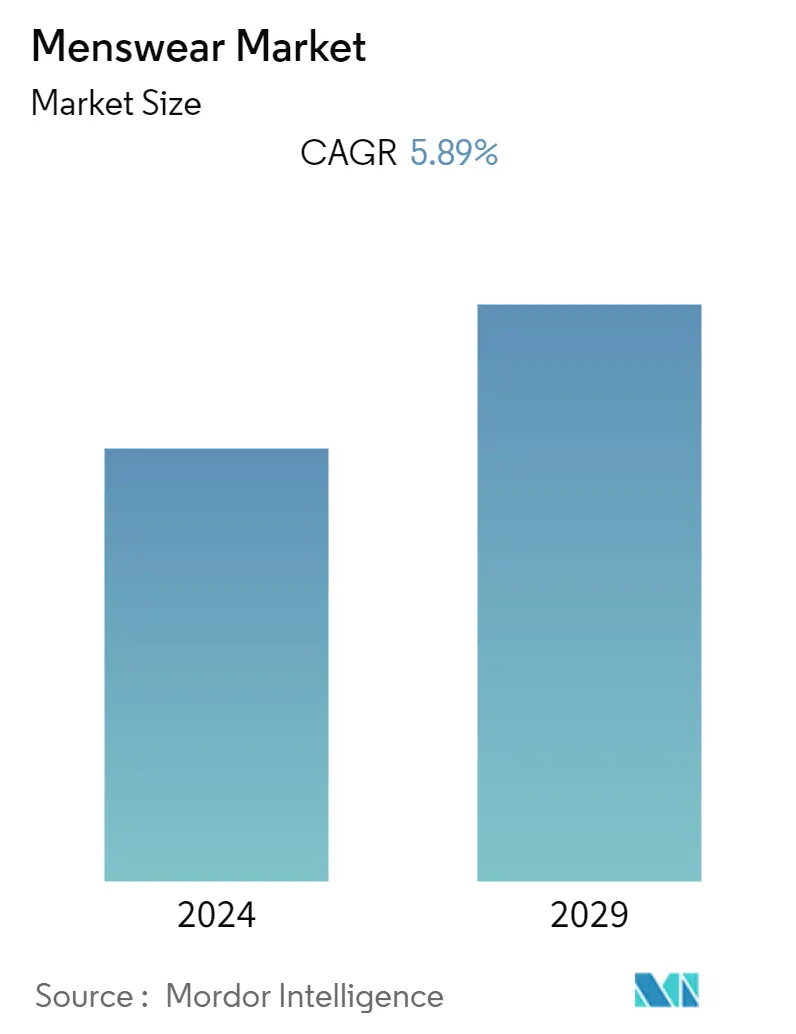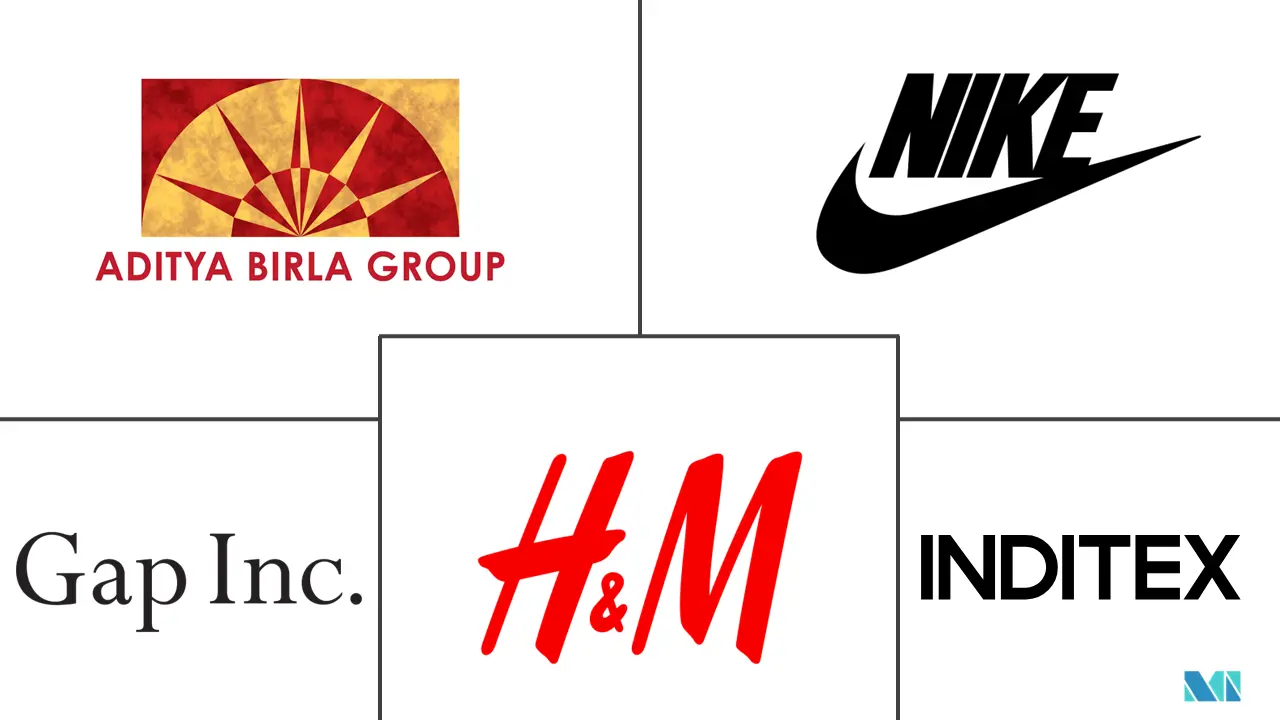Market Size of Menswear Industry

| Study Period | 2019 - 2029 |
| Base Year For Estimation | 2023 |
| CAGR | 5.89 % |
| Fastest Growing Market | Asia-Pacific |
| Largest Market | North America |
| Market Concentration | Low |
Major Players
*Disclaimer: Major Players sorted in no particular order |
Menswear Market Analysis
The menswear market is projected to register a CAGR of 5.89% over the forecasted period.
Men these days are very up-to-date about their appearance and fashion. The consciousness of fashion and clothing around the world is increasing. For every occasion, there is a different outfit for men these days. An increase in e-commerce websites, affordable clothing, and the increased purchasing power of consumers are driving the market. The market players adopt different strategies to attract consumers, such as offering promotional discounts, casting celebrities in their advertisements, and having festive sales. In addition, companies are developing new shopping experiences for consumers to provide them with the finest shopping experience possible. For instance, in May 2022, H&M launched a new in-store shopping experience enabled by technology in the United States. This in-store shopping experience provides consumers with personalized recommendations, fast checkout, seamless payment, and upgraded delivery or return options.
The adoption of a luxury lifestyle among consumers has influenced the purchasing power of millennials to opt for luxury wear. People tend to spend on fashion wear, party wear, and even nightwear. Rapid growth and rising urbanization lead to a modern class of consumers with more money to spend who develop a growing passion for current fashion. The demand for occasion-specific clothing is growing within the menswear segment. Over the long term, the digitalization of online shopping apps, increased spending power, and awareness of clothing among men are expected to drive the market.
Menswear Industry Segmentation
Menswear means the clothes that are made for men which include shirts, pants, and seasonal wear as well. The global menswear market is segmented by product type, distribution channel, and geography. Based on product type, the market is segmented into trousers, denim, t-shirts, nightwear, winter wear, sportswear, and other product types. Based on distribution channels, the market is segmented into offline retail stores and online retail stores. By geography, the market is segmented into North America, Europe, Asia-Pacific, South America, and the Middle East and Africa. For each segment, the market sizing and forecasts have been done on the basis of value (in USD million).
| Product Type | |
| Trousers | |
| Denims | |
| T-shirts | |
| Winter wear | |
| Sports wear | |
| Other Product Types |
| Distribution Channel | |
| Offline Retail Stores | |
| Online Retail Stores |
| Geography | |||||||||
| |||||||||
| |||||||||
| |||||||||
| |||||||||
|
Menswear Market Size Summary
The menswear market is experiencing a dynamic transformation, driven by a heightened awareness of fashion and personal appearance among men globally. This shift is supported by the proliferation of e-commerce platforms, affordable fashion options, and increased consumer purchasing power. Companies in the sector are employing various strategies to attract consumers, such as promotional discounts, celebrity endorsements, and festive sales. The integration of technology in shopping experiences, like H&M's innovative in-store offerings, is enhancing consumer engagement by providing personalized recommendations and streamlined payment processes. The growing inclination towards a luxury lifestyle, particularly among millennials, is further propelling the demand for occasion-specific menswear, as urbanization and increased disposable income foster a modern consumer base with a penchant for contemporary fashion.
In regions like China and India, the menswear market is witnessing significant growth due to the young, fashion-conscious population and their focus on quality and style. The influence of fashion models and actors, coupled with the need for diverse attire for various festivals in India, is driving the market's expansion. Partnerships between local brands and renowned designers are enhancing the appeal of menswear, while the rapid economic growth and rising purchasing power in China are boosting demand for high-quality apparel. The competitive landscape of the menswear industry is marked by the presence of major global players such as Gap Inc., Aditya Birla Management Corporation, and Nike, who are leveraging innovative marketing strategies and strategic partnerships to expand their market presence. As online shopping continues to gain traction, the menswear market is poised for further growth, with the Asian-Pacific millennial demographic playing a pivotal role in shaping future trends.
Menswear Market Size - Table of Contents
-
1. MARKET DYNAMICS
-
1.1 Market Drivers
-
1.2 Market Restraints
-
1.3 Porter's Five Forces Analysis
-
1.3.1 Threat of New Entrants
-
1.3.2 Bargaining Power of Buyers/Consumers
-
1.3.3 Bargaining Power of Suppliers
-
1.3.4 Threat of Substitute Products
-
1.3.5 Intensity of Competitive Rivalry
-
-
-
2. MARKET SEGMENTATION
-
2.1 Product Type
-
2.1.1 Trousers
-
2.1.2 Denims
-
2.1.3 T-shirts
-
2.1.4 Winter wear
-
2.1.5 Sports wear
-
2.1.6 Other Product Types
-
-
2.2 Distribution Channel
-
2.2.1 Offline Retail Stores
-
2.2.2 Online Retail Stores
-
-
2.3 Geography
-
2.3.1 North America
-
2.3.1.1 United States
-
2.3.1.2 Canada
-
2.3.1.3 Mexico
-
2.3.1.4 Rest of North America
-
-
2.3.2 Europe
-
2.3.2.1 United Kingdom
-
2.3.2.2 Germany
-
2.3.2.3 France
-
2.3.2.4 Russia
-
2.3.2.5 Italy
-
2.3.2.6 Spain
-
2.3.2.7 Rest of Europe
-
-
2.3.3 Asia-Pacific
-
2.3.3.1 India
-
2.3.3.2 China
-
2.3.3.3 Japan
-
2.3.3.4 Australia
-
2.3.3.5 Rest of Asia-Pacific
-
-
2.3.4 South America
-
2.3.4.1 Brazil
-
2.3.4.2 Argentina
-
2.3.4.3 Rest of South America
-
-
2.3.5 Middle-East and Africa
-
2.3.5.1 South Africa
-
2.3.5.2 Saudi Arabia
-
2.3.5.3 Rest of Middle-East and Africa
-
-
-
Menswear Market Size FAQs
What is the current Menswear Market size?
The Menswear Market is projected to register a CAGR of 5.89% during the forecast period (2024-2029)
Who are the key players in Menswear Market?
Gap, Inc., Aditya Birla Management Corporation Pvt. Ltd., Nike Inc., Industria de Diseño Textil, S.A. and H & M Hennes & Mauritz AB are the major companies operating in the Menswear Market.

